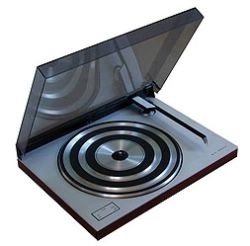BeoGram 3400

Beogram 3400 was designed to play back quadraphonic-encoded records and incorporated an MMC 5000 with a Shibita diamond stylus. An optional CD4 decoder could be specified to allow play back of that type of LP as well SQ discs which could be played by any record player.
Quadraphonic sound
Bang & Olufsen produced two quadraphonic systems in the 1970s. The top model was Beosystem 6000 which comprised Beomaster 6000 and Beogram 6000. Beogram 6000 was a development of Beogram 4000 in that it was a tangential tracking turntable. It had an inbuilt CD4 decoder which was switchable. When ‘on’ it would detect the presence of the carrier frequencies and a display would illuminate on the record deck’s display as ‘4ch’.
The output of the Beogram was at line-level whether in 2- or 4-channel mode. The deck was attached to Beomaster 6000 via a 5-pin DIN lead with all the pins being wired. In Beomaster 6000 there was a replaceable board with a SQ decoder as standard. This was manually switchable. The operator therefore still needed to know the type of quad recording that was to be played. The purpose of the removable board was to allow upgrading should the record industry ever get its act together and find a common standard!
The second system was based on Beomaster 3400 and Beogram 3400 which had a radial deck and a smaller and simpler receiver. This again had similar functions. Beomaster 4000 and a few others had a facility called Ambiophonics which used a system of simulated four track sound from stereo records. Two Bang & Olufsen cartridges were made for playing CD4 records:
MMC5000 used a fairly standard Shibata profile
The top of the range MMC6000 used a profile designed by one of their own engineers – Subir Pramanik – and which bore his name
